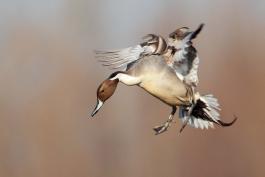Northern Pintail
A Northern Pintail (Anas acuta), lacking its usual elegance, fights a fierce headwind on landing at Marais Temps Clair Conservation Area. I captured this image during my third hour hiding along the shoreline of one of the area’s pools. As illustrated here, photographing waterfowl in extreme conditions often results in the most compelling images.
A large group of “pins,” the nickname for this species among waterfowlers, had been feeding and loafing across the lake, well out of range, since before sunrise. My optimism was waning fast as the flock showed no interest in relocating. As thoughts of a warm breakfast began to dominate my daydreams, a U.S. Fish and Wildlife Service survey vehicle rounded the corner where the pintails were concentrated. I watched with satisfaction as the entire group lifted off and approached my hiding place, almost hanging in the air with the 40 mph wind at their bills. As they entered the range of my 500 mm lens, I began tracking this single drake as it reversed thrust for landing, its whip-tail bent in the gust.
Pintails are dabbling ducks, feeding on grain, seeds, weeds, aquatic insects, and other morsels. They are considered fine table fare, not unlike the mallard, teal, and gadwall. Breeding and nesting occurs in the northern United States, Canada, and even farther north.
It’s no surprise that the northern pintail is one of the most beloved waterfowl among hunters and bird watchers. The drake’s long neck, graceful lines, and sweeping tail are exquisite, especially when the bird is in flight. Although muted in color, mostly chocolate-brown, cream-white, and gray, much of the pintail’s plumage is tightly striated in contrasting shades, and the back feathers, edged in white, adorn the bird like fine, pointed drapes (see inset photo). Even the bill of the drake pintail is eye-catching in black with slate-blue flanks. The hen pintail is much more subdued, mostly tan and brown, but identifiable in flight by the same lithe profile as the male.
The northern pintail is listed as a common migrant in Missouri with few documented nesting records. I have photographed them at a variety of locations from waterfowl hunting areas to the Missouri and Mississippi rivers. As with all waterfowl, I prefer photographing them in spring when their plumage is at its best, but I’ve found magnificent specimens in the fall, as well. I often find overwintering pintails in backwater sloughs of the Mississippi River.
This past winter, I encountered a large group of mid-winter pintails in a slough on the Upper Mississippi Conservation Area in St. Charles County. I sat in the snow each morning for several days, watching them feed and interact. Every once in a while, a drake would go on alert, stretching its long neck high into the air to evaluate its surroundings. During one of those moments, I captured the image featured in the inset. I’ve photographed almost every waterfowl visitor to Missouri, but none as svelte as the northern pintail.
—Story and photograph by Danny Brown
We help people discover nature through our online field guide. Visit on.mo.gov/1M3cWgI to learn more about Missouri’s plants and animals.


And More...
This Issue's Staff
Art Director - Cliff White
Associate Editor - Bonnie Chasteen
Staff Writer - Heather Feeler
Staff Writer - Kristie Hilgedick
Photographer - Noppadol Paothong
Photographer - David Stonner
Designer - Stephanie Thurber
Circulation - Laura Scheuler






















